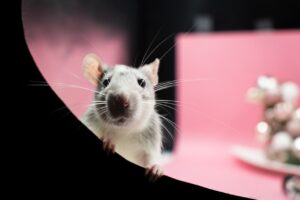Female Mice Sing for Sex
Female Mice Sing for Sex with Intricate Songs
Recent scientific discoveries have revealed that female mice produce complex, song-like vocalizations called ultrasonic vocalizations (USVs). These high-pitched sounds were once thought to be made only by male mice. However, we now know female mice sing intricate songs, especially when they are ready to mate.
Female mice singing plays an important role in courtship and reproduction. Understanding this newly discovered behavior provides insights into the evolution of vocal communication, social dynamics, and reproductive strategies in mammals.
Female Mice Singing Behavior
Description and Frequency
Scientists have found through auditory analysis that female mouse songs contain multiple syllables organized into more extensive phrases and motifs. Like bird songs, the vocalizations have a melodic quality.
The songs encompass a wide frequency range from 30kHz up to 120kHz, well beyond the upper range of human hearing. Technology like high-frequency microphones is needed to record and study mice songs.
Unreceptive females rarely sing. But behavior experiments reveal receptive females actively sing many hundreds of vocalizations per hour during peak sexual receptivity. This intense burst of singing serves to attract mates and advertise the female’s readiness to reproduce. The complex structure of female songs also signals reproductive fitness to males.
Comparison to Male Mice Singing
Both male and female mice produce courtship songs in the ultrasonic range. However, there are notable differences between the sexes. Male mice sing far more often throughout adulthood and generate longer and more repetitive songs. The male song has been more widely studied. Males sing not only during courtship but also to claim territories from other males and when they encounter the scent of female urine.
In contrast, female vocalizations are much more limited in context. Female mice sing almost exclusively during active sexual encounters when they are ready to mate. The vocalizations quickly begin when a receptive female detects male pheromones and hears a male courtship song. This duet facilitates reproduction.
Reproductive Role of Female Mice Singing
Attracting Mates
A major reason female mice sing is to attract male mates for reproduction. When males hear female courtship songs, they will approach and investigate the source. The male mouse will attempt to mate if the female is ovulating and still singing receptively.
Receptive females use certain song features to indicate interest and improve mating success. The female’s song gets the male’s attention and draws him nearer.
Communicating Fertility and Receptiveness
Ultrasonic vocalizations broadcast a female mouse’s hormonal status and fertility to potential mates. Non-receptive females rarely sing courtship songs. The very act of a female mouse vocalizing indicates she is in a sexually receptive estrus state.
By actively singing, females signal directly to males that they are ovulating and ready to mate. This vocal advertisement helps coordinate successful reproduction between the sexes.
Scientific Explanation of Female Mice Singing
Neural Mechanisms
The neural mechanisms that enable mice to sing involve interconnected brain circuits linking auditory perception and vocal motor control centers. Hearing male courtship song activates vocal motor areas of the female’s brain, eliciting a sung response.
During estrus, heightened estrogen levels amplify auditory cortex response to male vocalizations. This hormonal priming facilitates female song production. Specific cortical and subcortical regions control song features.
Mice lacking proper connections between auditory and vocal areas in the brain cannot produce normal courtship songs.
Research on mice brain anatomy and genetics is advancing our understanding of the neural basis for singing behavior in both sexes. Female mice employ similar circuits as males to translate auditory signals into the motor patterns of song.
Hormonal Factors
Female mice singing patterns are strongly influenced by fluctuations in reproductive hormones. Estrogen levels reach their peak just before sexual receptivity estrus. This primes the auditory cortex and vocal motor circuits to sing. Heightened estrogen during estrus makes female mice far more vocal in response to hearing male songs.
After mating, progesterone levels rise, which inhibits further song production. These hormonal changes act on neurons controlling vocalization context and frequency. The cyclic interplay of estrogen, progesterone, and other hormones modulates the singing patterns associated with courtship, mating, and fertility in female mice.
Insights into Female Communication
Analysis of female mouse songs is shedding light on the social communication dynamics between the sexes. When males pursue singing females, the females also slow down, enabling males to catch them faster. Females that do not sing back keep up their pace of movement.
Their singing patterns suggest complex information is being exchanged. Receptive females may use specific song features to indicate interest, improving mating success. The vocalizations likely communicate fertility status as well. This singing dialogue facilitates courtship and reproduction between mice.
Future Research Directions
Now that female mice songs can be detected and measured, numerous research opportunities have opened up. Comparisons of mouse courtship patterns could provide insights into social communication deficits in autism spectrum disorders.
Studies may also examine how genetics, hormones, and brain circuits influence singing behavior in mice of both sexes.
This discovery of female mouse songs illustrates how much is still unknown about animal communication.
Mice remain a highly useful model for broader neuroscience and behavioral research that can provide vital insights into human brain function as well. Recording mouse vocalizations will continue to unveil new findings about the hidden social world of these animals.
Introduction
Male sexual advertisements like the dancing displays of birds or the roaring contests of deer are some of the most conspicuous mating behaviors in the animal kingdom. These elaborate shows seem designed to grab attention and broadcast the signaller’s presence. In many species, more vigorous displays also increase mating success.
But such benefits come at a cost, whether from the risk of drawing predators, fights with competitors, or from the materials and energy required to develop and perform the display. Costly signaling theory proposes that only the highest quality males can bear these expenses, explaining the evolution of preferences for more elaborate signals.
Despite the central role of costs, we still understand little about how signalers actively adjust display effort based on their condition. Traditionally, “condition” refers to available energetic resources, often estimated from body mass and size.
But these are imprecise proxies. The weak links found between the display and such coarse metrics suggest the need for more direct physiological measures. Regulatory factors like hormones and nutrients offer insight into an animal’s somatic state. But few studies examine their relationship to behavioral variation.
To elucidate the physiology of display decisions, researchers studied a wild rodent with remarkably complex songs: Alston’s singing mouse (Scotinomys teguina). Male singing mice produce loud, melodic vocalizations, while females were thought to be silent.
See A Video: https://www.youtube.com/watch?v=Y4RIsY3-0XI
But new technologies revealed both sexes engage in vocal interchanges. This little-known species offers novel perspectives on the mechanisms governing investment in elaborate, costly signals.
Measuring Song Effort in Singing Mice
The songs of male Alston’s singing mice are among the most complex known among rodents. A single song contains a series of dozens of ascending frequency sweeps called notes, spanning sonic and ultrasonic frequencies from 10 to 43 kHz.
Songs can last up to 16 seconds, exceptionally long for a mouse. The songs are loud, likely reaching farther than the vocalizations of related species. Females prefer songs with higher note repetition rates.
Males modulate singing in social contexts, and song features indicate fitness. This hints singing is energetically expensive.
To quantify song effort, the researchers made studio-quality recordings of wild male mice. They measured features related to singing motivation seen in other species, like song length, number, amplitude, and latency to sing after playback.
These comprised a “song effort” axis via principal components analysis. A second axis described frequency modulation patterns, which may broadcast individual identity. Males showed tremendous natural variation along both song dimensions.
Assessing Body Condition
To relate the song to body condition, the team measured the following:
- Residual body mass (RBM): The standard proxy for energy reserves in field studies
- Plasma nutrients: Glucose, fatty acids, etc., indicating the current feeding state
- Metabolic hormones: Leptin, adiponectin, etc., signaling long-term energy reserves
These variables are separated into two main components: circulating nutrients and long-term energy reserves. RBM weakly tracked both. The hormone adiponectin strongly indicates body fat. Leptin had remarkable predictive power for song effort.
Linking Physiology to Singing Effort
RBM showed a weak positive trend with song effort. But hormones provided greater insight into a male’s perceived condition. Adiposity measures strongly predicted song effort (29% variance explained), while circulating nutrients did not.
Remarkably, the hormone leptin alone accounted for 39% of the variation in song effort. Leptin signals long-term energy reserves. Males with higher leptin sang more songs faster, with greater length—investing more in courtship display.
Discussion
This study revealed a nuanced picture of the condition’s multidimensional nature. Measures of adiposity and leptin provided powerful insight into male behavioral decisions. Plasma factors like leptin may be ideal for quantifying the condition’s effect on displays.
RBM poorly predicted song effort, consistent with past critiques. But adiposity hormones directly regulated investment in singing. Leptin, in particular, signaled fat stores available for energetically costly behaviors. Males in better condition sang with greater intensity.
These physiological variables offer several advantages for studying communication. Hormones like leptin are conserved across vertebrates and some invertebrates. Metabolic assays need only microliter plasma volumes. Analyzing mechanisms linking physiology to behavior will provide a deeper understanding of display decisions.
This approach also enables stronger tests of why songs and other advertisements become elaborate. Females may prefer intense displays for direct benefits like territorial quality or indirect benefits like “good genes” for offspring.
Measuring the male condition helps clarify the costs driving this evolution. Integrating behavioral, physiological, and neuroscience techniques will bring new perspectives to classical theories of sexual selection.
Overall, the remarkable songs of singing mice are shedding new light on the physiological regulation of investment in sexual displays.
Characterizing adiposity hormones provided novel insight into male behavioral decisions and trade-offs. This path promises to elucidate sensory mechanisms coupling an animal’s internal state to the expression of extravagant courtship behaviors.
The Importance of Female Mice Singing for Research
Evolutionary Implications
The discovery of female mice songs provides new perspectives on the evolution of mammal vocal communication. Complex courtship duets were thought to occur mainly in tropical birds and frogs. But female mouse singing demonstrates this ability has also evolved in mammals.
Mice songs may functionally resemble the choreographed antiphonal duets of tropical birds. In such species, pair bonding is strengthened through coordinated vocal exchanges. Mouse duets could similarly elicit an approach, promote pair formation, and facilitate mating. This challenges the assumption of female silence in rodents and other mammals.
Female contribution to vocal interactions can drive the elaboration of male vocal complexity over evolutionary time.
Mouse song research should investigate if female preferences shape the structural features of male songs. The interplay between the sexes may spur innovation in mammalian vocal displays.
Understanding Mammalian Communication
Mice are important biomedical models for vocal learning and communication deficits like autism.
But our understanding of mouse vocal behavior has been biased towards males. Detecting female mouse songs now allows research into the social functions and mechanisms of both sexes’ ultrasonic communications.
Mouse song playback studies can now explore the behavioral effects of male versus female calls on same-sex and opposite-sex listeners. This will reveal new insights into the information encoded in mouse vocalizations for social behaviors like courtship, territoriality, and parental care.
Elucidating female mice’s role in vocal interactions provides a complete picture of mouse communication dynamics. This will aid in interpreting mouse models of human social deficits and improving translations to clinical applications.
Potential Benefits of Female Mice Singing
Improved Mating Success
Female mouse courtship songs likely increase reproductive success. When a receptive female responds to the male song with her own singing, it clearly signals her fertile state. This vocal duet facilitates mating between the pair.
Females may also use unique song features to indicate selectivity, promoting their chance to mate with a preferred male. Coordinated vocal exchanges improve reproduction for both partners. Understanding female strategies for utilizing songs to screen potential mates is an important direction for future work.
Promoting Genetic Diversity
Complex female mouse songs could reduce inbreeding. In tropical birds, duetting helps prevent mating with close relatives. Mouse songs may serve a similar function.
Varied female preferences could also drive males to diversify their songs, expanding the pool of potential mates. Females singing may be an overlooked mechanism favoring outbreeding and population genetic health. Investigating these possibilities will reveal new selective pressures shaping mammal vocal complexity.
Challenges and Limitations in Studying Female Mice Singing
Difficulty Detecting and Analyzing Songs
A major barrier to progress is that mice sing at frequencies above human hearing. Specialized recording equipment is needed to study ultrasonic vocalizations. Open-source technological solutions are expanding song analysis capabilities but remain challenging to implement.
Automated machine learning analysis would accelerate parsing large volumes of mouse vocal data.
But current algorithms struggle with accuracy compared to manual annotation. Advances in this area are critical to capitalize on the insights mouse song can provide.
Influence of Environmental Factors
Mouse songs are also highly context-dependent. Males modulate singing in response to social settings and perceived threats. Female vocal behavior likely also varies across different environments.
Captivity may distort singing patterns important for natural behavior. Lab conditions alter courtship, parental care, and aggression. Developing techniques to monitor mouse songs in the wild will be crucial for evolutionary questions.
Overcoming these technical hurdles will maximize the value of mice communication research. But the potential insights into social behavior and neurobiology make this a worthwhile challenge.
Conclusion
The discovery that female mice sing complex courtship songs underscores how much remains unknown about mammalian vocal communication.
Novel technologies like high-frequency recordings are uncovering hidden dimensions of mouse behavior. Characterizing female vocal contributions provides exciting new research directions with broad neuroscience and evolutionary implications.
Relating physiological factors like leptin to male courtship singing effort also demonstrates the promise of bridging behavioral ecology with endocrinology.
Direct measures of hormones and adiposity better capture the condition’s multidimensional nature compared to proxies like body mass. Integrating physiology into studies of behavioral variation will bring deeper insight into animal decision-making.
Discoveries like female mice songs highlight the continued value of basic natural history observations. Even in model species like mice, fundamentally new perspectives on behavior emerge when researchers ask new questions. But capitalizing on these opportunities requires pushing methodological boundaries. Emerging technologies offer tantalizing windows into social dynamics, but only if their challenges can be overcome.




